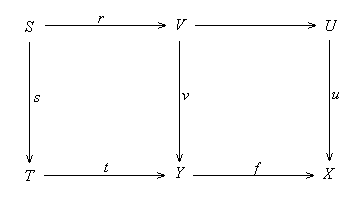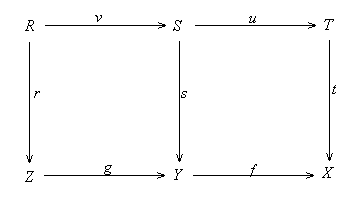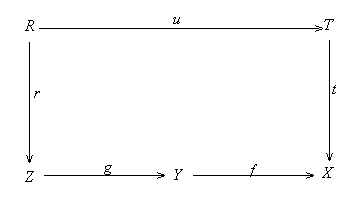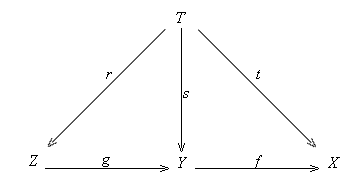Definition 2.2.1. (a) A set S
of maps to an object X is called a unipotent
cover on X if 0 --> X is the only map that is
disjoint with S.
(b) A map to X is unipotent
if it is a unipotent cover on X.
The term " unipotent " is suggested by the following (2.2.2) and (2.2.2.1):
Remark 2.2.2. Suppose S
is a set of maps to X. Then by (2.1.1)
we have
(a) S is unipotent iff ![]() S
= 0X.
S
= 0X.
(b) S is unipotent iff ![]()
![]() S
= 1X.
S
= 1X.
Example 2.2.2.1. Consider a homomorphism
of commutative rings ![]() :
A --> B. The induced morphism Spec(
:
A --> B. The induced morphism Spec(![]() ):
Spec (B) --> Spec (A) is unipotent in the category
of affine schemes iff the kernel of
):
Spec (B) --> Spec (A) is unipotent in the category
of affine schemes iff the kernel of ![]() is a nilpotent ideal. This suggests
that the dual of unipotent map is called a nilpotent
map.
is a nilpotent ideal. This suggests
that the dual of unipotent map is called a nilpotent
map.
Unipotent covers (resp. unipotent maps) play the important role of surjective covers (resp. maps) in categorical geometry. For instance, a map in the categories of sets, topological spaces and affine schemes is unipotent iff it is surjective, and this is true for most of natural metric sites.
Proposition 2.2.3. (a) Isomorphisms
are unipotent maps.
(b) Any pullback of a unipotent map is unipotent.
(c) Composites of unipotent maps are unipotent.
(d) If f: Y --> X and g: Z --> Y are two
maps and f°g is
unipotent then f is unipotent.
(e) 0 --> X is unipotent iff X = 0.
Proof. (a) is obvious.
(b) Suppose v: V --> Y is the pullback of a unipotent
map u: U --> X along a map f: Y --> X. Consider
a non-initial map t: T --> Y. Since u is unipotent,
the non-initial map ft is not disjoint with u, thus we can
find a non-initial map s: S --> T such that fts factors
through u. Since v is a pullback of u along f,
we can find a map r: S --> V such that ts = vr. This
shows that t is not disjoint with v. Hence v is unipotent.



Proposition 2.2.4. Suppose f:
Y --> X is a map. Suppose S and
T are two sets of maps to Y.
Write f*(S) for the
set {fu | u ![]() S}.
S}.
(a) If T ![]()
![]()
![]() S
then f*(T)
S
then f*(T) ![]()
![]()
![]() f*(S).
f*(S).
(b) If f is a mono and f*(T) ![]()
![]()
![]() f*(S)
then T
f*(S)
then T ![]()
![]()
![]() S.
S.
Proof. (a) Assume T ![]()
![]()
![]() S.
Consider a map t: T --> Y in T.
Since t
S.
Consider a map t: T --> Y in T.
Since t ![]()
![]()
![]() S,
for any non-initial map s: S --> T we can find a non-initial
map w: W --> S such that tsw factors through some
map v: V --> Y in S.
Then the non-initial map ftsw factors through the map fv
in f*(S). Thus f°t
S,
for any non-initial map s: S --> T we can find a non-initial
map w: W --> S such that tsw factors through some
map v: V --> Y in S.
Then the non-initial map ftsw factors through the map fv
in f*(S). Thus f°t ![]()
![]()
![]() f*(S).
Since this is true for any t in T,
we obtain f*(T)
f*(S).
Since this is true for any t in T,
we obtain f*(T) ![]()
![]()
![]() f*(S).
f*(S).

Definition 2.2.5. A mono u: U -->
X is normal
if u generates the normal sieve ![]()
![]() {u}
(i.e. sieve(u) =
{u}
(i.e. sieve(u) = ![]()
![]() {u}).
Equivalently, u is normal iff t
{u}).
Equivalently, u is normal iff t ![]()
![]()
![]() {u}
implies that t factors through u.
{u}
implies that t factors through u.
Proposition 2.2.6. (a) Isomorphisms
and initial maps are normal monos.
(b) Any normal unipotent mono is an isomorphism.
(c) Composites of normal monos are normal monos.
(d) The pullbacks of normal monos are normal monos.
(e) Any intersection of normal monos is a normal mono.
(f} Any complement of a mono is a normal mono.
Proof. (a) is obvious.
(b) If u is a normal unipotent mono then u generates
the unit sieve 1X by (2.2.2.b)
and (2.2.5), thus is an isomorphism.
(c) Suppose f: Y --> X and g: Z --> Y are
two normal monos. Suppose a map t: T --> X is in ![]()
![]() {fg}.
Then t
{fg}.
Then t ![]()
![]()
![]() {t}
{t} ![]()
![]()
![]() {fg}
{fg}![]()
![]()
![]() {f}by
(2.1.1.c). Since f is normal, t
factors through f in a map s: T --> Y. Since f
is a mono, by (2.2.4.b)
{f}by
(2.1.1.c). Since f is normal, t
factors through f in a map s: T --> Y. Since f
is a mono, by (2.2.4.b) ![]()
![]() t
=
t
= ![]()
![]() fs
fs ![]()
![]()
![]() fg implies that s
fg implies that s ![]()
![]()
![]() s
s ![]()
![]()
![]() g.
Since g is normal, s factors through g in a map r:
T --> Z. Thus t = fgr factors through fg. This shows
that fg is normal.
g.
Since g is normal, s factors through g in a map r:
T --> Z. Thus t = fgr factors through fg. This shows
that fg is normal.

(e) follows from (2.1.2.b).
(f) follows from (2.1.2.a).
Corollary 2.2.7. If A is an analytic category then any singular or analytic mono is normal.
Proposition 2.2.8. If A has pullbacks, then a mono is normal iff its pullback along any map is not proper unipotent.
Proof. Suppose u: U --> X is a mono. If u is normal
then any pullback of u is normal by (2.2.6.d),
thus not proper unipotent by (2.2.6.b). Conversely,
assume the condition is satisfied. If t: T --> X is a map
in ![]()
![]() {u},
then its pullback along u is normal unipotent, thus an isomorphism
by (2.2.6.b), which implies that t factors
through u. This shows that u is normal.
{u},
then its pullback along u is normal unipotent, thus an isomorphism
by (2.2.6.b), which implies that t factors
through u. This shows that u is normal.
Definition 2.2.9. A class of objects is called uni-dense if any non-initial object is the codomain of a map start from a non-initial object in the class.
Proposition 2.2.10. Suppose C is a uni-dense class of objects. A map f: Y --> X is unipotent iff any map from a non-initial object in C to X is not disjoint with f.
Proof. The condiiton is clearly necessary. Conversely, assume the condition is satisfied. If t: T --> X is a non-initial map, then there is a non-initial map r: R --> T with the domain T in C. Now tr is not disjoint with f, so t is not disjoint with f.